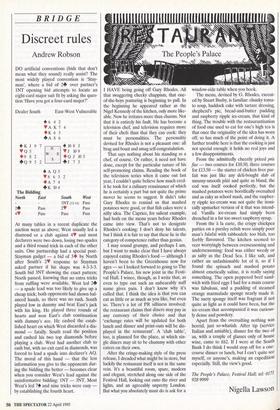BRIDGE
Discreet rules
Andrew Robson
DO artificial conventions (bids that don't mean what they sound) really assist? The most widely played convention is 'Stay- man', where a bid of 24 over partner's 1NT opening bid attempts to locate an eight-card major suit fit by asking the ques- tion 'Have you got a four-card major?'
Dealer South East-West Vulnerable North East South West 1NT (12.14) Pass 2+ Pass 2♦ Pass 4♦ Pass Pass Pass At many tables in a recent duplicate the auction went as above; West usually led a diamond or a club against 4V and most declarers were two down, losing two spades and a third round trick in each of the other suits. One partnership had a special post- Stayman gadget — a bid of 3♦ by North after South's 2V response to Stayman asked partner if his shape was 4-3-3-3. South bid 3NT showing the exact pattern; North passed, knowing that no extra tricks from cuffing were available. West led 2+ — a spade lead was too likely to give up a cheap trick; both opponents had shown bal- anced hands, so there was no rush. South played low in dummy and beat East's jack with his king. He played three rounds of hearts and won East's club continuation with dummy's ace. He cashed the estab- lished heart on which West discarded a dia- mond — fatally. South read the position and cashed his two top diamonds before playing a club. West had another club to cash but, with no exit card in diamonds, was forced to lead a spade into declarer's AQ. The moral of this hand — that the less information you give to the opponents dur- ing the bidding the better — becomes clear when you consider West's lead against the uninformative bidding: 1NT — 3NT. Most West's led 74 and nine tricks were easy by establishing the fourth heart.


























































 Previous page
Previous page